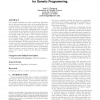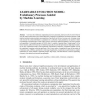50 search results - page 6 / 10 » Combining mutation operators in evolutionary programming |
GECCO
2010
Springer
13 years 11 months ago
2010
Springer
The original mechanism by which evolutionary algorithms were to solve problems was to allow for the gradual discovery of sub-solutions to sub-problems, and the automated combinati...
GECCO
2003
Springer
14 years 5 days ago
2003
Springer
Abstract. A brachistochrone is the path along which a weighted particle falls most quickly from one point to another, and a catenary is the smooth curve connecting two points whose...
ML
2000
ACM
13 years 6 months ago
2000
ACM
A new class of evolutionary computation processes is presented, called Learnable Evolution Model or LEM. In contrast to Darwinian-type evolution that relies on mutation, recombinat...
GECCO
2008
Springer
13 years 8 months ago
2008
Springer
In this paper an island model is described for the unconstrained Binary Quadratic Problem (BQP), which can be used with up to 2500 binary variables. Our island model uses a master...
GECCO
2006
Springer
13 years 10 months ago
2006
Springer
The learning classifier system XCS is an iterative rulelearning system that evolves rule structures based on gradient-based prediction and rule quality estimates. Besides classifi...


